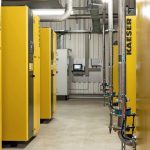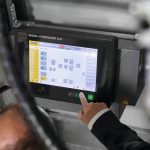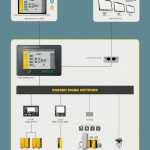The drive towards efficiency, reliability and – most importantly – energy savings and sustainable usage of resources, increasingly compels developers and users to optimise existing compressed air solutions ever further. Modern air stations are comprehensive systems, including compressors, cooling systems, dryers and filters. Even the individual components have auxiliary systems, such as ventilation or cooling-water systems. Moreover, stations are often incorporated into heat recovery processes in order to achieve optimal use of the available energy. The range and number of individual components comprising a complete compressed air system can therefore be considerable.
Complex systems such as these require an organising hand to guide them, which is where master controllers such as the Sigma Air Manager 4.0 come into play. By monitoring the individual components and optimally coordinating the interaction between them, these controllers transform the individual players into a truly cohesive team that operates reliably and efficiently.
Recently, the use of systems such as these has already yielded a certain degree of optimisation. For instance, master control systems have for some time been capable of coordinating multiple compressors with different internal controllers, thereby ensuring that they supply the required set working pressure with maximum energy efficiency.
Yet there were still certain aspects that harboured significant potential for improvement. For example, communications between components and controllers still presented considerable potential for development and refinement. Some compressors are equipped only with floating contacts, which merely signal the basic status of the compressor (running / not running), rather than integrated controllers capable of detecting and communicating more detailed information about the compressor.
Furthermore, within the wide range of different bus systems available on the market, many are not compatible with one another or can only be made compatible with difficulty. This makes it hard to communicate all the necessary information regarding the system’s status.
Contemporary Ethernet-based bus systems enable more straightforward integration and communication of large data volumes. Systems equipped with modern internal controllers therefore already rely on Ethernet technology in order to communicate with other networked systems.
The entire system in view
The very latest controllers are true management systems which act like master controllers, yet are capable of much more. They gather information regarding the connected components and measurement points via Ethernet and are able to transfer these data without restriction to a centralised control system for evaluation.
The various methods used to gather information mean that the data can be used in a range of ways, with the ultimate aim of optimising the compressed air system. For example, whilst also ensuring maximum operational reliability and efficiency, the compressors and treatment components are switched on and off as needed, or operate at partial load, so that compressed air volumes and quality always remain in step with actual demand.
Management systems additionally monitor all other relevant system parameters, such as the temperature and pressures in the compressor and compressed air treatment system, as well as ambient conditions. This means the control system can also check whether the compressor cooling is performing as required and whether environmental conditions (temperature, pressure) are consistent with requirements. Where heat recovery systems are used, all associated parameters are also integrated into the management system.
Predictive maintenance
However, progress is not restricted to system operation alone. Maintenance represents a key area to consider when it comes to maximising cost-effective compressed air production. It goes without saying that poorly maintained systems with contaminated coolers or filters, for example, also operate with impaired specific package input power. New management systems therefore also take maintenance parameters into account and include them in overall optimisation strategies. Over the long-term, predictive maintenance not only reduces both energy consumption and costs, but also helps boost value-retention of the system as a whole. Moreover, complex monitoring enables the creation of predictive maintenance schedules. Monitoring can take place either internally within the company, or via an external service provider. For some years now, providers of compressed air systems have offered operators the option of remote monitoring. This means that they not only benefit from continuous monitoring of the operating parameters for their daily compressed air generation, but the system is also constantly checked and rechecked from a life-cycle management point of view. In this way, any increase or decrease in requirements can be identified early on and the air station optimised accordingly.
Documentation and management
In addition to control of the compressor station itself, management systems also enable the gathering, forwarding and evaluation of important data to produce documentation in accordance with ISO 50001.
Management systems collect data regarding air consumption and, where applicable, heat recovery. Based on these data, costs are automatically calculated and can be assigned once again to the various individual components within the system. These functions, including visualisation, are accessed via the web using standard browsers without the need for any additional software.
Smart, safe, efficient
Compressed air management systems such as the Sigma Air Manager 4.0 optimise your compressed air supply and require no additional software to provide valuable cost-monitoring information.
Such management systems not only control the compressors in accordance with compressed air demand, but also monitor the compressed air system as a whole, as well as any associated auxiliary systems, with optimum efficiency. They also offer enhanced data evaluation options, coupled with predictive maintenance, remote monitoring and life-cycle cost management, which in turn deliver improved reliability with more detailed information regarding the system, significantly reducing operating costs.
Pepperl+Fuchs SE, Mannheim, Germany
Hall A1, Booth 143
Kaeser Kompressoren SE, Coburg











